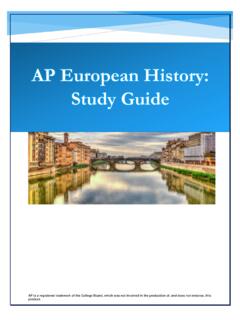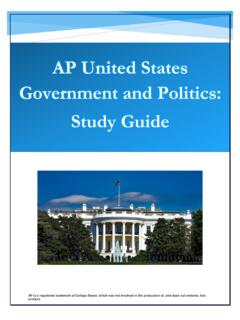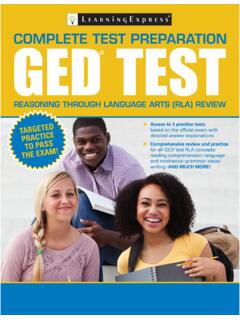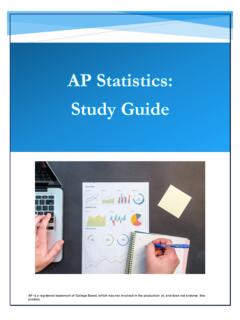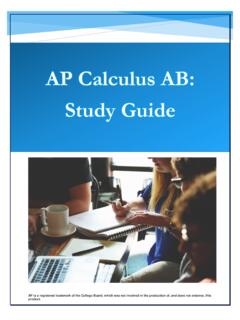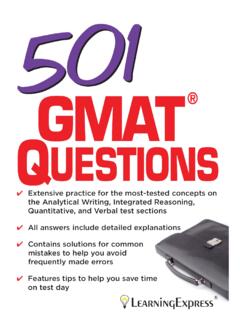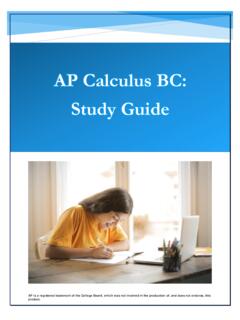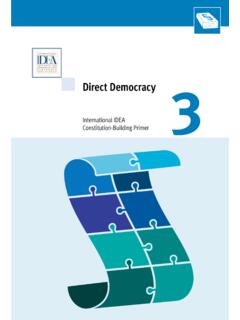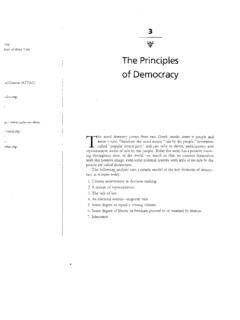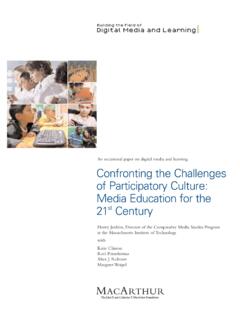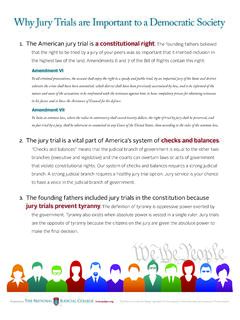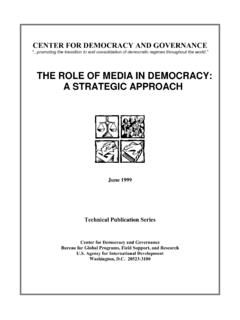Transcription of AP US Government and Politics Study Guide
1 AP United States Government and Politics : Study Guide AP is a registered trademark of College Board, which was not involved in the production of, and does not endorse, this product. Key Exam Details The AP Government and Politics exam will test your knowledge of material typically covered in a one-semester college introductory-level course about Government and Politics . The 3-hour exam is comprised of 55 multiple-choice questions (50% of the exam) and 4 free-response questions (50% of the exam). The exam covers the following topics: Foundations of American democracy : 15 22% of test questions Civil Liberties and Civil Rights: 13 18% of test questions Interactions Between Branches of Government : 25 36% of test questions Political Participation: 20 27% of test questions American Political Beliefs and Ideologies: 10 15% of test questions This Guide will give you a review of all major exam topics, with an emphasis on the terms covered in each exam section.
2 Following every topic overview are sample AP multiple-choice questions so you can get a sense of how information will be presented on test day. Foundations of American democracy About 15 22% of the questions on your AP exam will cover the topic Foundations of American democracy . Types of democracy Let s take a look at the various types of democracy that exist in political theory. Direct democracy allows citizens to directly govern and make laws. It is considered a chaotic and inefficient system, especially in societies with large populations. It also has significant risks like the majority violating the rights of the minority. participatory democracy values broad based public participation in governing. In theory, it keeps Government closest to the people and their opinions. Representative democracy /republicanism is a theoretically more efficient system that allows citizens to elect representatives who then govern for them. It allows a smaller and more manageable group to make decisions more quickly.
3 Republicanism retains important elements 1 of broad public participation in Government while making governing less chaotic and more efficient. Elite democracy /elitism favors allowing the best educated and most qualified members of society to govern in the best interests of the country. This system favors having a small group of the best-informed people to govern. Majoritarian democracy promotes majority rule. It places power in the hands of the majority and allows them to govern based on their ideals, and values efficiency in governing and decisive elections. Critics of majoritarian democracy argue that majorities can easily violate the rights of minorities if sufficient safeguards are not in place.
4 They also argue that majoritarian democracy s winner-take-all elections make Politics a zero-sum game where candidates and groups are encouraged to do whatever it takes to win. Consensus democracy promotes the sharing of power across diverse groups. Power is disbursed throughout the system, and therefore all groups are required to compromise with one another. Critics of consensus democracy argue that it is inefficient and creates unnecessary hurdles to decision making, especially when quick decisions are needed in times of crisis. Founding Documents The Declaration of Independence, created by the Second Continental Congress on July 4, 1776, declares the British Colonies in North America to be a free and independent country. Authored by Thomas Jefferson and others, the Declaration of Independence relies heavily on the concepts of Natural Rights, Popular Sovereignty, and Social Contract Theory to argue that the former colonies are empowered to create their own Government because of the abuses suffered under British rule.
5 Natural rights are rights that exist in a state of nature, or where no Government exists whatsoever. English philosopher John Locke proposed these rights in his work, Two Treatises of Government . Locke proposed that there are three basic natural rights: life, liberty, and property. These rights are negative rights, which means that they are a restriction on others. It means that other people ought not to kill us (Life), ought not to interfere with us (Liberty), and ought not to take what is ours (Property). Popular sovereignty is a concept that people are the highest level of power in society. The power of Government to govern comes from the people. When people consent to be governed, Government gains its legitimacy. Social contract theory states that people should consent to be governed and in exchange the Government will provide protections and certain public goods to the people. Proposed by English philosopher Thomas Hobbes in Leviathan, social contract theory is a fundamental theory that supports constitutional governments, because 2 constitutions are a form of social contract.
6 The people agree to give Government certain powers in exchange for other considerations. The Articles of Confederation and Perpetual Union was the United States first constitution. Created by the Second Continental Congress on November 15, 1777, it created the first national Government for the United States. Like the Declaration of Independence, the Articles of Confederation relied heavily on John Locke s theory of natural rights and very limited Government roles. The Articles also gave our country its name, The United States of America. Confederation is a form of Government where smaller Government units, in this case the states, are the sovereign or the highest level of authority. States empower the national Government to do very limited tasks while maintaining most of the control at the state level. This idea is borrowed from Native Americans. Under the Articles of Confederation, the national Government s size, power, and role was very limited. The national Government under this document was structured as follows: One branch of Government Congress.
7 Equal representation from each state in Congress All laws must be passed with a super-majority Congress has the power to create a national currency, borrow money in the name of the United States, declare war, raise an army, and establish relations with foreign countries The Articles of Confederation is known more for its failures than its successes. Under the Articles, the national Government did not have: An executive branch A national judiciary The power to tax The power to compel states to obey national laws or contribute funding Any power that was not expressly delegated or specifically written in the Articles This last point prevented the national Government from having any minor legal tools necessary to execute the specific powers and responsibilities that it was given. Under the Articles, the national Government lacked significant power and the states largely failed to live up to their responsibilities in the system, like adequately funding the national Government for the payment of debt, etc.
8 The nation suffered an economic depression and significant disfunction. Shays Rebellion was an uprising in western Massachusetts to protest economic conditions, high taxes, and abusive debt and tax collections. Led by Revolutionary War veteran Daniel Shays, it demonstrated the weakness of the national Government under the Articles when the 3 Congress was unable to fund an army to put down the uprising. The result of this rebellion led to calls for a constitutional convention to fix the national Government . The Constitution of the United States In the aftermath of Shays Rebellion, a constitutional convention was called in the summer of 1787. The initial idea behind this convention was to fix the Articles of Confederation.
9 This idea was abandoned relatively quickly in favor of creating a whole new system of Government . The new Government abandoned the system of Confederation in favor of a system of federalism, where the national Government and state governments would share powers but the national Government would have significantly more powers than under the Articles of Confederation. The constitutional convention featured a series of proposals and compromises that allowed the new Government to be formed. The initial compromise was over representation. The Virginia Plan, proposed by the large states, created a Congress with two houses both based on representation. The New Jersey Plan, proposed by the small states, created a Congress with one house based on equal representation from each state. Another compromise was reached between slaveholding and non-slaveholding states, known as the Three-Fifths Compromise, in which free persons would be counted as a whole person and slaves would be counted as three-fifths of a person.
10 In addition to this compromise on slavery, non-slaveholding states also agreed not to regulate the slave trade prior to the year 1808. The Great Compromise, also known as the Connecticut Compromise, created a bicameral, or two-house legislature, with the House of Representatives being based on population and the Senate being based on equal representation from each state. Drawing on the ideas proposed by French political philosopher Charles Montesquieu, the national Government was separated into three branches: the executive branch, the legislative branch, and the judicial branch. Each branch of Government was given specific and unique powers that could not be exercised by the other branches. This system is known as separation of powers. The idea behind separation of powers is to use the structure of Government to control Government and the officials within the Government . In addition to separation of powers, each branch of Government was given certain powers over the other branches.
